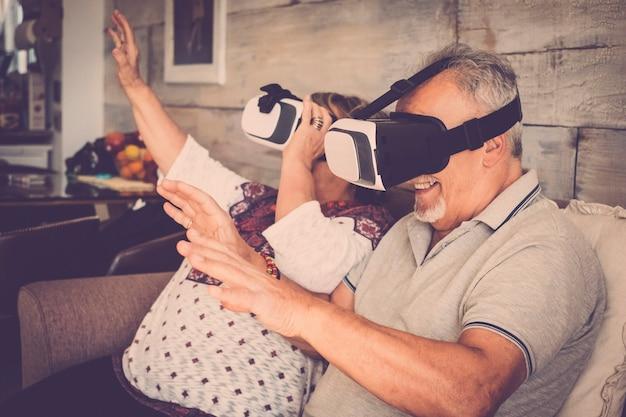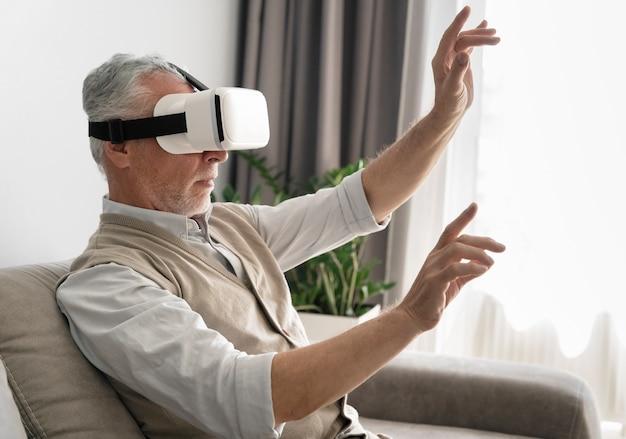As technology advances, so does its potential to improve the quality of life for hospice patients. With the use of virtual reality (VR), patients can explore new environments, revisit cherished memories, or simply find a moment of relaxation from physical discomfort. But what is virtual hospice, and how does it work? In this blog post, we will dive into the benefits of virtual reality for hospice patients and how this innovative technology is being used in palliative care. From how hospice works at home to the types of technology being used, we’ll cover it all. Let’s explore how VR is making a significant difference in the lives of hospice patients.
Virtual Reality for Hospice Patients: A New Way to Escape Reality
As someone who’s on hospice care, it’s easy to get stuck in a rut of sadness, pain, and discomfort in your final days. But what if there was a way to escape reality, even for just a little while, and experience something new? That’s where virtual reality comes in handy.
What Is Virtual Reality
Virtual reality, or VR, is a computer-generated simulation of a 3D environment that can be interacted with in a seemingly real or physical way using specialized electronic devices such as a headset with a screen or gloves with sensors. Virtual reality can be used in many applications, including entertainment, education, and even healthcare.
How Virtual Reality Can Help Hospice Patients
While you may think virtual reality is just another entertainment platform, it actually has the potential to improve the quality of hospice care. It can help reduce anxiety, offer distraction, ease pain, and facilitate communication with loved ones and hospice staff.
For example, hospice patients who are experiencing severe pain can use VR to take their mind off of the physical sensations, and instead, enjoy a virtual tour of a foreign land or an imaginary underwater world. Additionally, patients who are bedridden for long periods can feel as if they have traveled to distant places or interacted with people who are no longer around, giving them a renewed sense of purpose and control.
Risks and Concerns
Of course, like with any new technology, there are potential risks and concerns that need to be addressed. Patients who are prone to nausea or motion sickness may find using VR uncomfortable. Additionally, there may be concerns about how much time patients spend using VR and whether it could be detrimental to their mental health.
It’s important to say that virtual reality should never completely replace real-world interaction and communication with loved ones and hospice providers. It should be seen only as a supplement to traditional hospice care.
The Future of Virtual Reality in Hospice Care
As of today, many hospice care providers across the world are experimenting with virtual reality and its application to hospice care. As technology improves and becomes more accessible, it’s exciting to see what the future holds for this innovative solution and how it can continue to benefit hospice patients and their families.
In conclusion, hospice care is not the end of life. With virtual reality, hospice patients can take their minds off reality and enjoy a new world of possibilities. It’s a small comfort that can make all the difference in a patient’s final days.
What is Virtual Hospice
Virtual hospice is a form of hospice care that is delivered through technology. It allows patients to receive hospice care from the comfort of their own home, using virtual reality technology. Virtual hospice uses a combination of video, audio, and interactive tools to provide patients with the care they need, no matter where they are located.
How Does Virtual Hospice Work
Virtual hospice works by connecting patients with hospice care professionals through technology. Patients can access virtual hospice care from their computers, smartphones, or other devices. Virtual hospice care professionals can provide patients with information about their condition, medications, and other aspects of their care. They can also provide emotional support and counseling to patients, helping them to cope with the challenges of their illness.
What Are the Benefits of Virtual Hospice
There are many benefits to virtual hospice care. For one, it allows patients to receive care from the comfort of their own home, which can be reassuring and comforting to patients who may not want to leave their homes. Virtual hospice also allows patients to receive care from a wider range of hospice care professionals, regardless of where they are located. This can be especially important for patients who live in rural or remote areas, where access to hospice care may be limited.
Is Virtual Hospice Right for Everyone
Virtual hospice may not be right for everyone. It is best suited for patients who are comfortable with technology and who have access to the necessary devices and equipment. It may not be the best option for patients who require hands-on care or who need constant monitoring. However, for many patients, virtual hospice can be a valuable source of support and care, allowing them to remain connected to their healthcare team and to receive the care they need, no matter where they are.
How to Qualify for Hospice Care
Hospice is a type of healthcare service that is designed to provide comfort and support to people who are terminally ill and have a life expectancy of six months or less. If you or a loved one is considering hospice care, it’s crucial to understand the eligibility requirements so that you can make informed decisions about the service.
Reach Out to Your Doctor
The first step in getting hospice care is to talk to your doctor. The doctor will assess your condition and determine whether you qualify for hospice care. If you do, your doctor will provide you with a referral to a hospice agency.
Meet Hospice Eligibility Criteria
To be eligible for hospice, you must meet the following criteria:
-
Terminal Illness: You have a life expectancy of six months or less if your illness runs its normal course.
-
Treatment Goals: Your treatment goals have shifted from curative to palliative care, which aims to relieve symptoms and manage pain.
-
Diagnosis: Your condition has been diagnosed by a doctor or healthcare provider.
-
Prognosis: Your prognosis must be verified by two healthcare providers, with one being your primary care provider.
Discuss Hospice Care with Your Family
It’s essential to involve your family in the hospice care decision-making process. Discuss your plans for hospice care with them and listen to their concerns. They should understand that hospice is a way to ensure that your last months of life are comfortable and pain-free.
Select a Hospice Provider
Once you meet the eligibility criteria, you can choose a hospice provider. You can either opt for a non-profit or a profit hospice organization. Your doctor can provide you with a list of hospice providers in your area. Make sure to choose a hospice provider that you feel comfortable with and that meets your needs.
In conclusion, hospice care can be a positive addition to your end-of-life journey. Speak with your doctor, meet the eligibility criteria, talk with your family, and choose a hospice provider that meets your needs. It’s never too early to explore hospice care and understand how it can benefit you or a loved one in need.
Can a Hospice Patient Travel
As much as we would like to say yes, unfortunately, the answer is not a straightforward one. It depends on the specific patient’s condition and the mode of transportation. However, we can provide some helpful insights.
Air Travel
Air travel can be quite uncomfortable and stressful for a hospice patient. It’s not just the altitude that can be problematic, but also the long hours of sitting and the potential exposure to infections. However, some airlines do offer special medical services that can make a flight more comfortable for a patient.
Ground Travel
Ground travel can be a viable option for hospice patients who want to travel but don’t want to go on a plane. However, it’s essential to consult with the physician before embarking on a road trip. A doctor can provide recommendations on the best mode of transportation that can reduce the discomfort of traveling for a patient.
Cruise Travel
Cruise ships are excellent for patients who want to travel without being subjected to the rigors of air or ground travel. Most cruise lines have robust medical facilities and can accommodate different medical needs, including hospice care.
Virtual Travel
Virtual travel is an excellent alternative for hospice patients who cannot physically travel but still want to experience new places. Virtual reality headsets can transport users to the most exotic locations worldwide and provide the opportunity to experience nature, culture, and history without actually traveling.
In conclusion, while traveling may not be possible for all hospice patients, it’s important to consult with a physician on the best mode of transportation that can make the experience comfortable. However, if travel is not possible, virtual reality offers a great way to explore the world from the comfort of your own home.
How Hospice Care Works from Home
Hospice care is no longer limited to inpatient healthcare facilities. With advances in medical technology and patient care strategies, many hospice patients can now receive the same quality of treatment and attention at home.
Benefits of Hospice Care at Home
One of the most significant benefits of receiving hospice care at home is that patients can feel more comfortable surrounded by their familiar surroundings. Instead of being admitted to a hospital, patients can recover in their own beds, with their families and loved ones to provide necessary support.
Who Provides Home Hospice Care
Home hospice care teams typically include a doctor, nurse, social worker, and other medical professionals who work collaboratively to manage a patient’s physical, social, emotional, and spiritual needs. Patients who receive hospice care at home can also benefit from dietary and rehabilitative services as well as counseling and therapy services.
How to Set Up Hospice Care at Home
To start hospice care at home, patients need to be examined and evaluated by a physician who can then write a prescription for hospice care. Patients can choose the hospice care provider they prefer, among those with which their insurance company works. After patients sign an agreement with their hospice provider, the hospice team conducts an assessment and develops a care plan tailored to the patient’s unique needs.
Cost of Home Hospice Care
Most medical insurance providers, including Medicare and Medicaid, cover hospice care at home. The hospice provider usually charges a per-day rate, inclusive of all care components provided by the team. Be sure to confirm with your medical insurance provider to determine what costs may also be managed under your policy.
With home hospice care, terminally-ill patients can receive compassionate support in the comfort of their own homes, surrounded by the presence of their loved ones. The hospice care team works closely with patients and their families to ensure that patients receive the best quality of life while managing their symptoms.
How Virtual Reality is Used in Palliative Care
Palliative care is not just about treating the body. It involves providing emotional, psychological, and spiritual support to patients with life-limiting illnesses. Virtual reality (VR) is one of the technologies that have been introduced to hospice care in recent years. Here are some ways VR is used in palliative care:
Distraction from Pain and Anxiety
Pain and anxiety are two of the most common symptoms experienced by hospice patients. VR can help distract patients from pain or anxiety by transporting them to a different environment. For example, a patient can explore a virtual beach, watch a movie, or play a game. This can reduce the need for medications and improve the patient’s quality of life.
Encourages Social Interaction
Hospice patients often feel lonely and disconnected from the outside world. With VR, patients can participate in simulated social events like concerts or games with other patients. This fosters a sense of community and helps alleviate the feeling of isolation.
Virtual Reality Therapy
Virtual reality therapy is a type of psychotherapy that uses computer-generated simulations to create a simulated environment. In palliative care, this type of therapy can help patients overcome phobias, manage anxiety, and relieve stress.
Enhances Spiritual Support
Virtual reality can also be used to enhance spiritual support for patients. For example, a patient can explore a virtual cathedral and meditate, or visit a holy site in a different part of the world. This can help patients find meaning and purpose, and improve their overall well-being.
In conclusion, VR is revolutionizing the way hospice patients receive palliative care. From reducing pain and anxiety to improving spiritual support, VR is providing a unique and valuable service. As technology continues to improve, we can only expect VR to become an even more integral part of hospice care.
How Virtual Reality Can Help Patients
As we all know, virtual reality has taken the world by storm. What started as a technology used by gamers is now proving to be beneficial in health care. Many researchers believe that virtual reality can help patients, especially those in hospice care.
Distracts Patients from Discomfort
One of the benefits of virtual reality for hospice patients is that it helps them forget about their discomfort. When used as an alternative to traditional methods of pain relief, virtual reality can transport patients to a different world and distract them from what’s going on in their bodies.
Provides Opportunities for Respite
Being in a hospice is no joke. Patients are often confined to their rooms, and it can be challenging to interact with others or view life outside the hospice walls. Virtual reality can change that. Hospice patients can visit different places and experience new things through VR, providing moments of respite from their predicament.
Helps Patients Connect with Loved Ones
Virtual reality is also a great way to allow hospice patients to connect with their loved ones, especially those who live far away. Many virtual reality apps and programs allow users to meet up with others in a virtual space and enjoy activities such as watching a movie together or playing games.
Elevates Mood and Decreases Anxiety
Depression and anxiety are common in hospice patients. Research shows that virtual reality can elevate mood and decrease anxiety levels among hospice patients. Being immersed in a different world or experiencing something new can help patients forget about their worries and boost their overall well-being.
Can Foster Positive Memories
For hospice patients, making positive memories can be challenging, given their circumstances. Virtual reality can solve that problem by providing them with the opportunity to create new and exciting experiences. It’s never too late for them to create memories that they will cherish forever.
In summary, virtual reality is a promising technology that can provide hospice patients with much-needed distraction, respite, and positivity. From alleviating pain to connecting with loved ones, VR has the power to make their final days more comfortable and enjoyable.
What type of technology does hospice use
When you think of hospice care, you might envision a quiet room with a bed and IV drip. But did you know that technology plays a significant role in improving the quality of life for those in hospice care? Here are just a few of the innovative technologies that hospice teams are using to ease the physical and emotional pain of their patients:
Wearable health trackers
Hospice providers are utilizing wearable fitness trackers to monitor their patients’ physical activity, heart rate, and sleep patterns. This data helps care teams to detect if their patients’ might be in pain or discomfort and to catch any health problems early before they escalate.
Virtual reality
Virtual reality (VR) technology is being used in hospice care to transport patients to different virtual environments, enabling them to experience things they may have never been able to encounter. Hospice patients are now able to fulfill their bucket lists by virtually climbing a mountain or exploring the ocean depths. VR technology provides a therapeutic escape from physical discomfort and offers both mental and emotional benefits to the patients and their loved ones.
Telehealth
Telehealth is now one of the most popular cutting-edge technologies used in hospice care. The technology enables patients to speak with their clinicians virtually without the need for in-person visits. With telehealth, patients can receive regular check-ins, meet with palliative care teams, and communicate with their families anytime and anywhere, providing effective and supportive care.
Smart speakers and assistants
Smart speakers and virtual assistants like Amazon Alexa and Google Home are becoming a valuable resource for hospice care teams, allowing patients to request pain relief, reminders, and even playing their favorite music. Smart speakers can provide social interaction for hospice patients who have difficulty communicating with people, while virtual assistants help patients with mobility challenges.
While hospice care is still a challenging and emotionally powerful experience, technology offers patients greater comfort, dignity, and quality of life. By embracing the latest tools available, Hospice care teams are doing everything possible to ensure patients’ illness journey, though tough, is manageable, and as comfortable as possible.
Virtual Reality in Palliative Care: A Systematic Review
Palliative care can be incredibly challenging, both for the patients themselves and for the caregivers who look after them. Virtual reality has emerged as an innovative solution for this issue, promising to provide patients with a sense of relief by providing them with access to relaxing or immersive virtual environments.
The Benefits of Virtual Reality in Palliative Care
A systematic review has shown that virtual reality can improve the palliative care experience in numerous ways. First and foremost, it can offer patients a safe and effective way to cope with physical or emotional pain by providing an immersive, distraction-based experience. This can also help reduce stress and anxiety that can accompany both the patient and the caregiver.
Second, the review suggests that virtual reality can also promote healing and therapeutic outcomes that may help improve overall quality of life, promote socialization, and improve symptom management.
Third, virtual reality can enhance the patient experience and reduce the need for medications or other interventions that may be problematic for patients in palliative care. This is particularly important since medications can often have negative side effects that may worsen the situations for palliative care patients.
Future of Virtual Reality in Palliative Care
The systematic review also provides a glimpse into the future of virtual reality in palliative care. With advances in technology and virtual reality, it’s expected that more customized and personalized experiences will be available for patients, tailored to their specific needs and preferences.
Furthermore, virtual reality can enable palliative care patients to engage in activities that may have been difficult for them previously or that they would never have had a chance to experience otherwise. For example, visiting exotic locations, attending cultural events, and even participating in social activities can all be possible with virtual reality technology.
Overall, virtual reality has immense potential to improve the palliative care experience both for patients and their caregivers. The systematic review suggests that there is a growing interest in using VR for this purpose, and that with further research and development, the potential benefits can be even bigger in the future.



